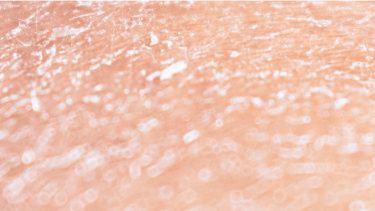Xeroses
There are several types of xerosis:
- Senile xerosis
- Uremic xerosis
- Xerosis of colored skin
- Xerosis of the diabetic foot (see dedicated page in section Diabetic foot pathologies)
- Read more
-
Senile xerosis is xerosis observed in the elderly due to the physiological aging of the skin.
It is characterized by dry, rough, cracked and scaly skin.Itching (particularly on the lower back, arms and legs1) is present in over 50% of elderly people2 , with or without associated scratching lesions and a subsequent risk of superinfection.
It results from the physiological aging of the epidermis, its appendages (sweat glands) and a reduction in the fatty substances in the stratum corneum. As in the general population, xerosis can be exacerbated by irritants (soaps, wools, antiseptics, caustic products, etc.) and the environment (temperature, humidity, winter).
Over 50% of people aged 65 suffer from xerosis1.
1 - Izumi, R., Negi, O., Suzuki, T., Tominaga, M., Kamo, A., Suga, Y., Matsukuma, S., & Takamori, K. (2017). Efficacy of an emollient containing diethylene glycol/dilinoleic acid copolymer for the treatment of dry skin and pruritus in patients with senile xerosis. Journal of Cosmetic Dermatology, 16(4), e37-e41.
https://pubmed.ncbi.nlm.nih.gov/28371078/
2 - Fourzali, K. M., & Yosipovitch, G. (2019). Management of Itch in the Elderly: A Review. Dermatology and Therapy, 9(4), 639-653.
Management of Itch in the Elderly: A Review | Dermatology and Therapy (springer.com)
Uremic xerosis is a frequent chronic dermatological complication in patients with chronic renal failure, particularly those on renal dialysis.
It presents as dry, rough, cracked, fissured skin and scales. It particularly affects the legs, back, chest and hands.It is frequently associated with severe itching.
The cause is as yet unknown, but is thought to be due to a number of factors: skin dehydration, impairment of the skin's barrier function, irritation caused by external substances (e.g. surfactants in soaps) or internal factors such as the accumulation of uremic toxins (waste products from the breakdown of diet-related proteins, for example)1.
Xerosis occurs in around 75% of renal dialysis patients. The intensity of uremic xerosis may be mild (30 to 40% of patients), moderate (35 to 50%) or severe (15 to 30%)2. In most cases, it disappears after renal transplantation.
1 - Szepietowski, J. C. (2004). Uraemic xerosis. Nephrology Dialysis Transplantation, 19(11), 2709-2712. https://doi.org/10.1093/ndt/gfh480
2 - Balaskas E., Szepietowski J.C., Bessis D., Ioannides D., Ponticelli C., Ghienne C., Taberly A., Dupuy P. Randomized, double-blind study with glycerol and paraffin in uremic xerosis. Clin J Am Soc Nephrol. 2011; 6(4): 748-52.
Xerosis in people with black skin is a physiologically known xerosis.
Like other xeroses, it is characterized by dryness. It can manifest itself as white, scaly skin, especially on the legs, upper limbs and face.
Colored skins have the same hydration capacity as other skins, but tend to dry out more strongly in a dry climate. Dryness can be even greater when coupled with limescale in the water, excessive bathing or showering, or low skin hydration1.
1 - Wan, D. C., Wong, V. W., Longaker, M. T., Yang, G. P., & Wei, F. C. (2014). Moisturizing different racial skin types. The Journal of clinical and aesthetic dermatology, 7(6), 25-32


Summaries of publications and clinical results
Find all our summaries by expertise.
View all summariesWant to read on?
This access is reserved for professionals, registered on Pierre Fabre For Med.
To access the full content, please register or log in if you already have an account.